Nov 11, 2024 – Opening Ceremony of the 7th 100-Day English Prayer, Paying Respects at the Memorial Altar of Venerable Jongsang, Chief Abbot of Bulguksa Temple
Hello. Today is the day foreign practitioners begin their 1000-Day Practice prayer.
After completing his morning prayer and meditation, Sunim attended the opening ceremony of the 7th 100-Day Prayer for foreign participants in the 1000-Day Practice at 8 AM. Yesterday, Jungto practitioners worldwide who use Korean began their 100-Day Prayer, and today, Jungto practitioners worldwide who use foreign languages started their 100-Day Prayer.
As all foreign Jungto practitioners entered the video conference room, the host warmly welcomed them.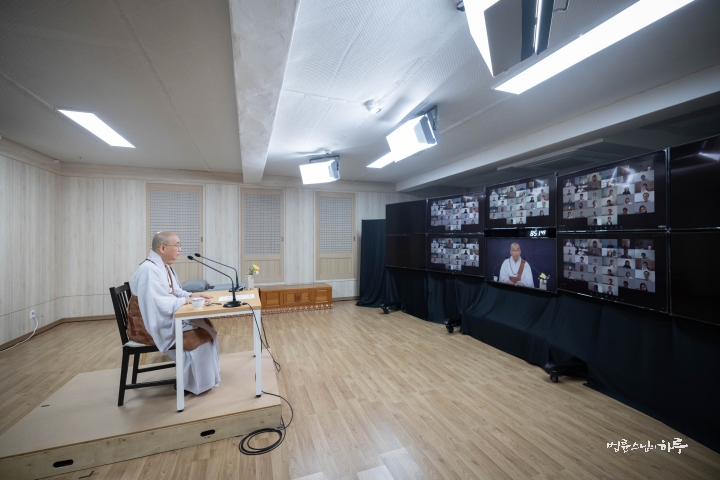
“Hello and welcome to the 7th one hundred-Day Practice Opening Ceremony of the 1st 1000-Day Practice.”
Fifteen foreign 1000-Day Practice participants from the United States, Canada, Hong Kong, Korea, China, Bhutan, Italy, Australia, and the United Kingdom joined the 7th 100-Day Prayer. First, they shared their experiences from the past 100 days of dedicated practice. After a few people raised their hands and shared their thoughts, Keith, who is studying the Human Buddha curriculum at Jungto Dharma School, shared his practice experience via video.
“I was really happy when I ran into the Jungto Dharma School Intro to Buddhism 1. I learned a lot and I had a great experience in that course. And then following on from that course, I started the thousand-day practice. I initially felt some resistance due to how demanding it is—especially considering the arthritis in my knees—but I was determined to give it a try. I realized that a challenge for me was shifting from intellectual understanding to truly experiencing the teachings. I do feel like I have made some progress, largely thanks to the small group of Jungto practitioners that I practice with almost every morning. When I think about my suffering, there’s something like a veil over it now that wasn’t there before. I think there’s a little less suffering and a little more equanimity. Although gradual, I do feel like progress is happening. So I have been pleased with that and I’m just very grateful to be doing this with the Sangha.”
Next, everyone together bowed three times to Sunim, requesting a Dharma talk. Sunim explained in detail to the foreign Jungto practitioners why Jungto Society, which operates on a volunteer basis, considers practice to be the most important. He also urged them to prioritize diligent practice in their activities for the next 100 days.
“The various social activities or good deeds that Jungto Society does for the world are secondary compared to your individual practice. The most important thing is that Jungto Society is a gathering of practitioners. In a gathering of practitioners, the most crucial aspect is each individual’s practice to free themselves from their own suffering. It is only when practice forms the foundation that all of Jungto Society’s activities become meaningful. Without a foundation in practice, it merely amounts to doing good deeds while causing distress to those who volunteer.
When you practice diligently every day to keep your mind clear and bright, you will no longer have regrets or feel a sense of sacrifice. That’s why you must not lose sight of your practice. Nothing in this world is more important than yourself. You should always maintain the perspective that you are the master of your own life. Jungto Society is a gathering of people walking the path of the Buddha. It’s not an organization with separate masters and servants, but rather a gathering of bodhisattvas. It’s just that when we do what the world needs, we each take on different roles because the types of work and roles needed by the world vary. With this perspective in mind, I hope you will continue to practice diligently for the next hundred days.”
Following this, questions were taken about concerns that arise during practice. Two people pressed the raise hand button and asked Sunim questions. One of them sought Sunim’s advice on how to manage their mind when intense emotions arise during meditation.
How Should I Handle Intense Emotions During Meditation?

“There are two approaches: emergency treatment and fundamental treatment. The emergency treatment is to open your eyes and stop meditating. In other words, it’s covering up the exposed wound again. However, this is not healing; it’s just stopping the immediate outbreak. This is because if left unchecked, it could erupt so explosively that it might lead to violent behavior or the onset of mental illness.
The method for fundamentally treating rather than temporarily covering the wound is to allow the emotion to explode once. Letting the emotion burst out like this can also help in overcoming trauma. However, this method is dangerous to do alone. It should be done with a professional who can observe and respond in case of violent behavior or mental illness.
The continuous rise of emotions indicates that you’ve lost focus on your breath. Therefore, the best method is to keep returning to the breath and focusing on breath awareness, no matter how much emotion arises. This is like holding onto a rope during a storm; no matter how strong the wind blows, you can endure until the storm passes. But if you let go of the rope, you can easily be swept away by the wind. Just as you need to grip the rope tightly to withstand the storm, you need to maintain continuous awareness of your breath, no matter what changes occur in your body or mind. Then, just as a storm eventually subsides on its own, the emotional changes will also subside.
However, overcoming an emotional crisis once doesn’t mean the trauma-induced wound completely disappears. As you repeatedly overcome such experiences, the intensity of the emotions that arise gradually weakens. Through this process, emotional regulation becomes natural in daily life. Instead of forcefully controlling emotions through determination, emotions are automatically regulated by being aware of their arising. It’s not easy to reach this state quickly, which is why consistent practice is necessary.
Healing emotional wounds from childhood is much more difficult. Childhood experiences are described as being engraved in stone, leaving a lasting imprint. In contrast, experiences formed after a certain level of growth can be compared to calligraphy written on a rock. Wounds acquired later in life are easily erased, but childhood wounds seem to disappear only to reappear repeatedly. That’s why when raising children, you should always be careful not to inflict wounds, especially when they are young.”
“Thank you. I understand.”
Lastly, after answering the question, everyone recited the Four Great Vows.
The live broadcast of the 7th English 100-Day Prayer Opening Ceremony ended with a group photo.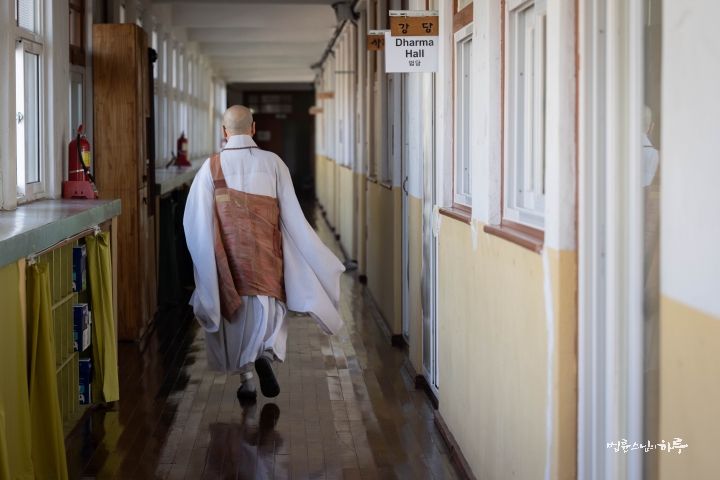
Sunim immediately moved to the Dubuk Retreat Center office to meet with the farming team about next year’s farming plans and this year’s kimchi-making plans. First, Sunim made suggestions for next year’s farming plan.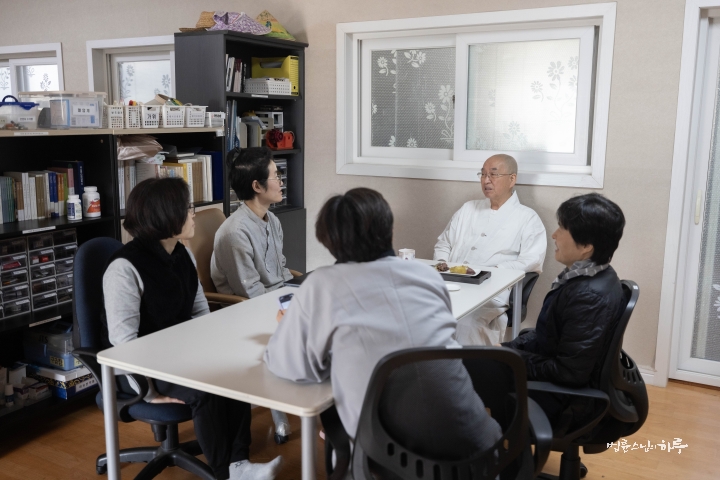
“It seems the greenhouses are not being used efficiently. Couldn’t we plant crops that would be more efficiently produced in greenhouses? Currently, we’re planting crops in greenhouses that could be grown in open fields.
Also, it would be good to research methods to produce vegetables early in spring. The crops grown in greenhouses are mainly for winter and spring harvests, right? So, after the harvest ends in December, it would be good to sow vegetable seeds throughout the greenhouse. It’s best to create a small greenhouse inside the main greenhouse, making a double-layered structure. If that’s difficult due to lack of manpower, just covering with plastic is fine. Let the seeds sprout inside during winter, then remove the plastic around February. With the outer greenhouse still in place, we can start eating vegetables from late February or early March. If we sow seeds in March, it takes too long for them to sprout. By sprouting them over winter, the vegetables grow immediately when temperatures rise in spring. How about operating just one greenhouse for vegetable harvesting during winter?”
“Yes, we’ll try that.”
They then discussed the kimchi-making plan. The entire community needs to gather at Dubuk Retreat Center for three days to make kimchi together, but there’s a shortage of available workforce. They checked how to recruit more people and in what order to make kimchi before concluding the meeting.
After lunch, on the day before the funeral of Elder Monk Daegung Jongsan Daejongsa of the Jogye Order, Sunim visited the memorial altar at Museoljeon Hall in Bulguksa Temple to pay his respects.
When he arrived at Museoljeon Hall in Bulguksa Temple around 2 PM, there was a continuous line of monks from various temples coming to pay their respects.
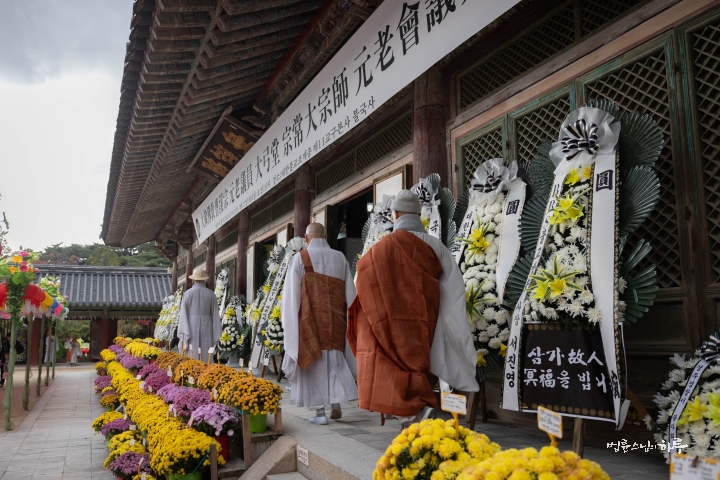
After signing the guest book, Sunim offered three bows before the portrait of Jongsan Daejongsa.

After offering incense, he greeted the disciples of the late monk.
After paying respects, Sunim was guided by Jongcheon Sunim, the chief monk of Bulguksa Temple, to Chongji Hall located next to Geungnakjeon Hall.
“The chairman of the Elder Council would like to see you. Would you like to meet him briefly?”
“Yes, I’ll do that.”
The tiled roof of Chongji Hall was covered with colorful autumn leaves. Sunim had tea with Jagwang Daejongsa, the chairman of the Elder Council of the Jogye Order.

During the tea time, a procession of elder council members continued to pay their respects.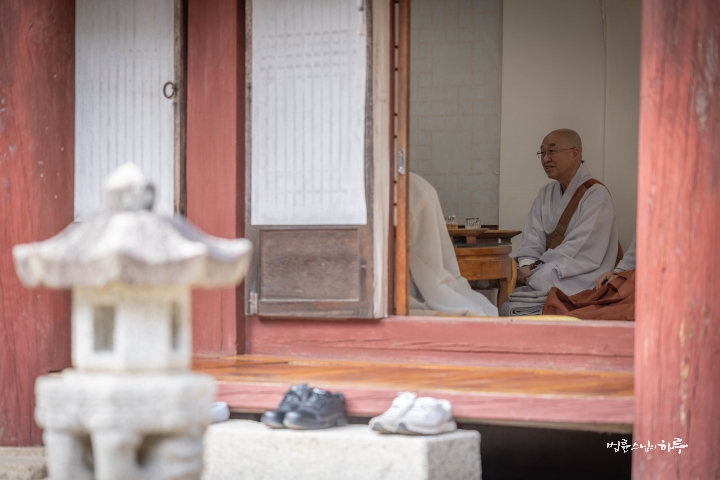
Sunim exchanged greetings with various monks before leaving Bulguksa Temple after 3 PM.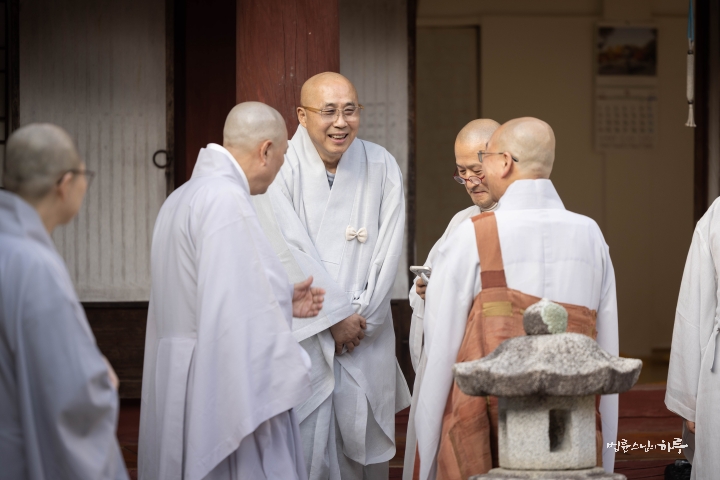

Along with Venerable Yoosu, who had also come to pay respects, Sunim stopped by Gwaereung (King Wonseong’s tomb) for a brief walk. After the walk, he bid farewell to Venerable Yoosu and returned to Dubuk Retreat Center.
As the sun set, Sunim spent the evening indoors proofreading manuscripts and handling work matters before concluding the day’s activities.
Tomorrow, he plans to work indoors all day, have an online meeting with Jungto Society executives in the evening, and then head to Seoul.




